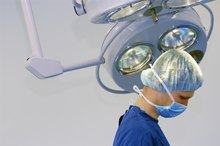Diastasis recti is an abdominal malformation that commonly occurs in infants, and in women who have been pregnant multiple times. In infants, the condition is usually harmless and does not warrant excessive worry or medical attention. However, complications can arise that may require extensive treatment. Some kinesiologists feel that diastasis recti is a bigger deal than most mainstream doctors realize.
Symptoms
The signs of diastasis recti become noticeable when an affected infant strains its abdominal muscles, such as when he tries to sit up or laugh. A raised ridge that runs from the sternum to the groin may appear. This ridge is actually the contents of the abdomen pushing through a divide in the rectus abdominus muscles, which are the muscles that cover the front of the abdomen. A normally developed baby will not have this gap between the muscles, and, therefore, no ridge will appear when he strains.
- The signs of diastasis recti become noticeable when an affected infant strains its abdominal muscles, such as when he tries to sit up or laugh.
- This ridge is actually the contents of the abdomen pushing through a divide in the rectus abdominus muscles, which are the muscles that cover the front of the abdomen.
Diagnosis and Prognosis
Abdominal Hernia Signs & Symptoms
Learn More
A doctor can diagnose diastasis recti by palpating, or feeling, the frontal abdominal wall with her fingers. You can often feel the edges of the separated muscles yourself when the baby is lying on her back in a relaxed position. According to the University of Maryland Medical Center, the condition occurs most often in African American babies and premature babies. The presence of one or both of these factors may increase a doctor's certitude of diagnosis. The prognosis for an infant with diastasis recti is good; the condition usually clears up on its own as the abdominal muscles continue to form and eventually merge to fill in the gap.
- A doctor can diagnose diastasis recti by palpating, or feeling, the frontal abdominal wall with her fingers.
Complications and Treatments
Because the condition usually clears on its own, most doctors will not recommend any action be taken to correct diastasis recti in infants. On occasion, however, some of the abdominal contents may become herniated and get trapped in the diastasis recti gap as it closes. In these rare cases, surgical intervention may be necessary to fix the hernia and fully close the gap. Because a trapped hernia can occur as diastasis recti resolves itself, it is important that a physician monitor the progress of diastasis recti during an infant's normal pediatric appointments.
- Because the condition usually clears on its own, most doctors will not recommend any action be taken to correct diastasis recti in infants.
- Because a trapped hernia can occur as diastasis recti resolves itself, it is important that a physician monitor the progress of diastasis recti during an infant's normal pediatric appointments.
Diastasis Recti and Central Coordination Disorder
Can You Pull Muscles in Your Breast?
Learn More
Some practitioners of kinesiology feel that diastasis recti causes complications often overlooked by mainstream doctors. They believe that diastasis recti is associated with, and may partly be the cause of, a condition called Central Coordination Disorder, which is characterized by delayed and disturbed motor development. According to the Dynamic Neuromuscular Rehabilitation Center, as many as 30 percent of babies who have diastasis recti at birth may develop CCD later in life 1.
Affects of Central Coordination Disorder
The first signs of CCD caused in part, or in total, by an instance when diastasis recti remains partially unresolved, include lower back pain and ambulatory problems. These back problems occur because of the asymmetric or incomplete nature of the closing of the rectus abdominus muscles, which may not always be detected by a physician. These improperly formed muscles may exert unbalanced or uneven forces that may eventually misalign the rib cage or cause a subtle twist in the spine. Such abnormalities can then cause chronic pain, which, if endured without treatment, can cause improper motion mechanics and further abnormal skeletal developments.
- The first signs of CCD caused in part, or in total, by an instance when diastasis recti remains partially unresolved, include lower back pain and ambulatory problems.
- These back problems occur because of the asymmetric or incomplete nature of the closing of the rectus abdominus muscles, which may not always be detected by a physician.
Related Articles
References
- Dynamic Neuromuscular Rehabilitation Center: Diastasis Recti
- American Society of Plastic Surgeons. Liposuction Recovery. Accessed May 22, 2011.
- Gingrass MK. Liposuction. In Thorne CHM, Beasely RW, Aston SJ, Bartlett SP, Gurtner GC, Spear S, eds. Grabb and Smith’s Plastic Surgery, 6th ed. Philadelphia: Lippincott, 2007.
- Hunstad JP. Liposuction of the Hips and Thighs. In Evans GRD, ed. Operative Plastic Surgery. New York: McGraw Hill, 2000.
Writer Bio
Timothy Banas has a master's degree in biophysics and was a high school science teacher in Chicago for seven years. He has since been working as a trading systems analyst, standardized test item developer, and freelance writer. As a freelancer, he has written articles on everything from personal finances to computer technology.









